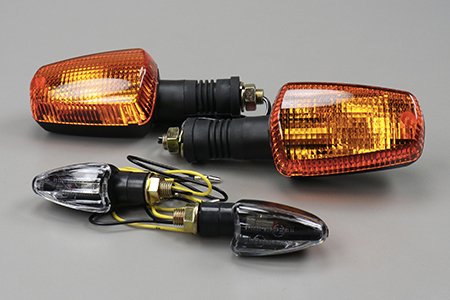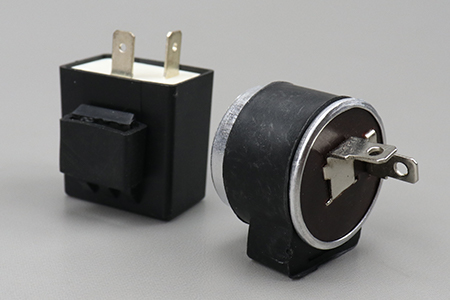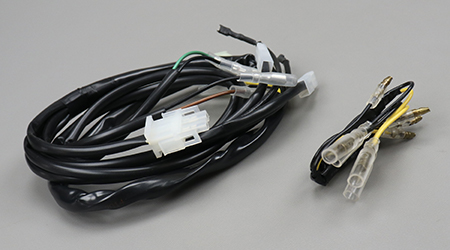
Home > general information > Tips and Guides > Technical guides > Generalists >
CHOOSE YOUR TURN SIGNALS
The essentials to know
Safety devices par excellence, turn signals have become over time one of the most easily and quickly changed parts on a two wheels. Whether they are approved or not, whether they are used or not, they contribute to the general line.
Be careful, however, not all are equal and some complications are discovered too late (when mounting them or once with a VP in your hands).
To be in good standing when you are driving, it is imperative to have indicators that work and thatfeel in good condition. serving mainly to warn other users changes of direction, iIt is important to have good indicators in working order.
The failure of a flashing light on a motorized two-wheeler is a real danger. The verification of their correct functioning is therefore do very regularly. Do not hesitate also to warn any user of a motorized two-wheeler who would be in this breakdown situation: this would be just as much to act for his safety as for yours, any change of direction being a source of danger on the road.
Turn signal faults and check
Classic turn signals
Motorcycle and scooter turn signals Bulb classic are the most common, come in all shapes and sizes and are often offered at attractive prices.
The blinkers with bulbs are often universal and compatible with all two-wheelers, however be sure to buy a turn signal with the same thread diameter (8 mm for most vehicles) as well as to respect the power of the turn signal of origin (10 watts or 21 watts depending on your two-wheeler).
The bulb indicator is systematically installed as standard on motorcycles and scooters. You will therefore find on our site the original bulb indicator for your machine.
LED turn signals
The LED turn signals are the latest innovation from manufacturers in terms of lighting, they have the advantage of consuming very little electricity, while offering great resistance to motorcycle vibrations, a long lifespan (up to 30 times greater than a classic bulb) and better visibility (up to 10 times greater).
The only downside to this new generation of turn signals is that they sometimes require the replacement of the central turn signal mechanism par an electronic control unit (problem that does not occur on the latest generations of motorcycles and scooters, perfectly compatible with LED technology).
Indeed, the power demanded par LED turn signals is much lower than that of bulb turn signals, and leads to much faster flashing if no intermediate system is installeds in place to limit the power of the original mechanical flasher unit (which provides constant power).
There are two issues with keeping your lights flashing fast:
You are no longer in compliance with the law
Eventually the mechanical indicator unit may be damaged.
If your two-wheeler does not have an electronic control unit but a mechanical control unit and you want to switch from classic lighting to powdery lightingar LED without changing the central, you can also add resistors. If you want to replace the filament bulbs on your turn signals par LED models, the replacement of the flasher unit will also be essential, the low resistance of the LEDs not allowing the flasher units to function correctly. It is also possible to add a resistor before each LED to avoid this change, but this will generate unnecessary over-consumption of current.
Vcheck voltage and power.
All turn signals need a voltage of 12 volts. The wattage required for bulbs can vary, between 21 watts and 10 watts or even much less for LEDs.Be careful when choosing the type of lighting: bulb or LED.
Diameter of the thread.
One of your turn signal light bulbs no longer comes on when after checking you find that it is still good?
The problem is then beneficial, it is surely a problem linked to the oxidation of the circuit on which the bulb rests. It is then sufficient to rub the points of contact between the bulb and the circuit. If the oxidation is too important, it is advisable to change the bulb holder.
If despite this the bulb still does not light up, then you will have to think of a Electric wires worn or even cut and in this case redo the circuit by changing the wiring harness .
Thanks to a tester multimeter, you will be able to control, measure, verify an electrical connection and its correct functioning.
The central or relay
La flashing center, also called flashing relay, operates on the electrical network 12 volts dyour two wheels. It is a small box, a few centimeters on the side, with two pins, at least.
The flasher unit receives current from the battery and restores it with regular cuts to cause the bulbs to flash. Some power plants still operate thanks to a bimetallic strip, an element that deforms when current flows. As it deforms it opens the electrical circuit and causes a brief cut. On other central units, the cut is made epar transistors. There are simple, so-called universal flasher units. They have two or three pins and manage a single flashing light.
Replacing the flasher unit is not always essential when a flasher fault occurs. The first instinct is to first check that all the flashing bulbs are working properly. VSar if the frequency of one of the turn signals is faster, it usually means that one of the bulbs is burnt out. If the initial problem persists, replacing the control unit may be a solution.
Wiring and Resistors
Le cabling motorcycles is different depending on the make and model of motorcycle. If you do not want to play with the wire stripper and the soldering iron there are specific cables allowing perfect compatibility between the connections of the universal indicators and those present on your two-wheeler.
The resistors are necessary to adapt indicators with a power different from the original one on certain motorcycles.
Conclusion
The approval of a flashing light is not made on its size but on its visibility when it is clear. An approved turn signal has the letter E engraved on the lens (European approval)
Motorcycle and scooter indicators are an essential safety element governed byar Article R313-14 of the Highway Code.
The other textual source on this subject is the Council Directive 93 / 92 / EEC, of October 29, relating to the installation of lighting and light signaling devices on motor vehicles with two or three wheels. This gives us a lot of information about the location of the indicators. This directive comes from the R48 regulation of the Geneva agreements on the same subject.
Today there are turn signals of all sizes and shapes and for all tastes. The choice is vast and the pitfalls are numerous: price, shape, finish, type of lighting and approval are all criteria to be taken into consideration before a purchase.


























